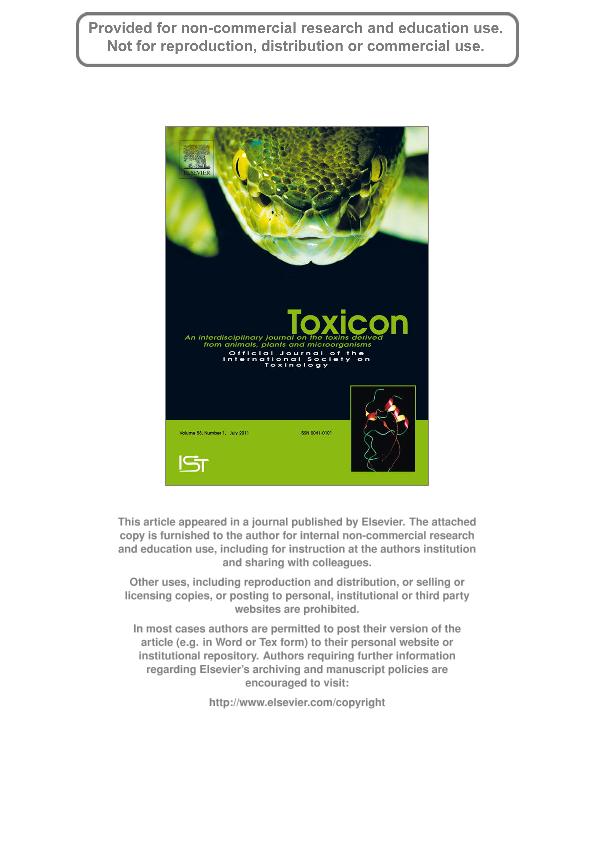Mostrar el registro sencillo del ítem
dc.contributor.author
Peichoto, María Elisa

dc.contributor.author
Tavares, Flávio L.
dc.contributor.author
DeKrey, Gregory
dc.contributor.author
Mackessy, Stephen P.
dc.date.available
2018-04-25T18:46:18Z
dc.date.issued
2011-07
dc.identifier.citation
Peichoto, María Elisa; Tavares, Flávio L.; DeKrey, Gregory; Mackessy, Stephen P.; A comparative study of the effects of venoms from five rear-fanged snake species on the growth of Leishmania major: Identification of a protein with inhibitory activity against the parasite; Pergamon-Elsevier Science Ltd; Toxicon; 58; 1; 7-2011; 28-34
dc.identifier.issn
0041-0101
dc.identifier.uri
http://hdl.handle.net/11336/43480
dc.description.abstract
Leishmania parasites of several species cause cutaneous and visceral disease to millions of people worldwide, and treatment for this vector-borne protozoan parasite typically involves administration of highly toxic antimonial drugs. Snake venoms are one of the most concentrated enzyme sources in nature, displaying a broad range of biological effects, and several drugs now used in humans were derived from venoms. In this study, we compared the effects of the venoms of the South American rear-fanged snakes Philodryas baroni (PbV), Philodryas olfersii olfersii (PooV) and Philodryas patagoniensis (PpV), and the North American rear-fanged snakes Hypsiglena torquata texana (HttV) and Trimorphodon biscutatus lambda (TblV), on the growth of Leishmania major, a causative agent of cutaneous leishmaniasis. Different concentrations of each venom were incubated with the log-phase promastigote stage of L. major. TblV showed significant anti-leishmanial activity (IC50 of 108.6 μg/mL) at its highest concentrations; however, it induced parasite proliferation at intermediate concentrations. PpV was not very active in decreasing the parasitic growth, and a high final concentration (1.7 mg/mL) was necessary to inhibit proliferation by only 51.5% ± 3.6%. PbV, PooV and HttV, at final concentrations of 562, 524 and 438 μg/mL respectively, had no significant effect on L. major growth. The phospholipase A2 of TblV (trimorphin) was isolated and assayed as for crude venom, and it also exhibited dose-dependent biphasic effects on the parasite culture, with potent cytotoxicity at higher concentrations (IC50 of 0.25 μM; 3.6 μg/mL) and stimulation of proliferation at very low concentrations. Anti-leishmanial activity of TblV appears to be solely due to the action of trimorphin. This is the first report of anti-leishmanial activity of rear-fanged snake venoms, and these results suggest novel possibilities for discovering new protein-based drugs that might be used as possible agents against leishmaniasis as well as tools to study the biology of Leishmania parasites.
dc.format
application/pdf
dc.language.iso
eng
dc.publisher
Pergamon-Elsevier Science Ltd

dc.rights
info:eu-repo/semantics/openAccess
dc.rights.uri
https://creativecommons.org/licenses/by-nc-sa/2.5/ar/
dc.subject
Antileishmanial Activity
dc.subject
Hypsiglena Torquata Texana
dc.subject
Philodryas Baroni
dc.subject
Philodryas Olfersii Olfersii
dc.subject
Philodryas Patagoniensis
dc.subject
Phospholipase A2
dc.subject
Trimorphodon Biscutatus Lambda
dc.subject.classification
Otras Ciencias Biológicas

dc.subject.classification
Ciencias Biológicas

dc.subject.classification
CIENCIAS NATURALES Y EXACTAS

dc.title
A comparative study of the effects of venoms from five rear-fanged snake species on the growth of Leishmania major: Identification of a protein with inhibitory activity against the parasite
dc.type
info:eu-repo/semantics/article
dc.type
info:ar-repo/semantics/artículo
dc.type
info:eu-repo/semantics/publishedVersion
dc.date.updated
2018-04-18T15:17:10Z
dc.identifier.eissn
1879-3150
dc.journal.volume
58
dc.journal.number
1
dc.journal.pagination
28-34
dc.journal.pais
Estados Unidos

dc.description.fil
Fil: Peichoto, María Elisa. Consejo Nacional de Investigaciones Científicas y Técnicas. Centro Científico Tecnológico Conicet - Nordeste; Argentina. Universidad Nacional del Nordeste. Facultad de Ciencias Veterinarias; Argentina. Univeristy of Northern Colorado; Estados Unidos
dc.description.fil
Fil: Tavares, Flávio L.. Univeristy of Northern Colorado; Estados Unidos
dc.description.fil
Fil: DeKrey, Gregory. Univeristy of Northern Colorado; Estados Unidos
dc.description.fil
Fil: Mackessy, Stephen P.. Univeristy of Northern Colorado; Estados Unidos
dc.journal.title
Toxicon

dc.relation.alternativeid
info:eu-repo/semantics/altIdentifier/url/https://www.sciencedirect.com/science/article/pii/S004101011100153X?via%3Dihub
dc.relation.alternativeid
info:eu-repo/semantics/altIdentifier/doi/https://doi.org/10.1016/j.toxicon.2011.04.018
Archivos asociados
